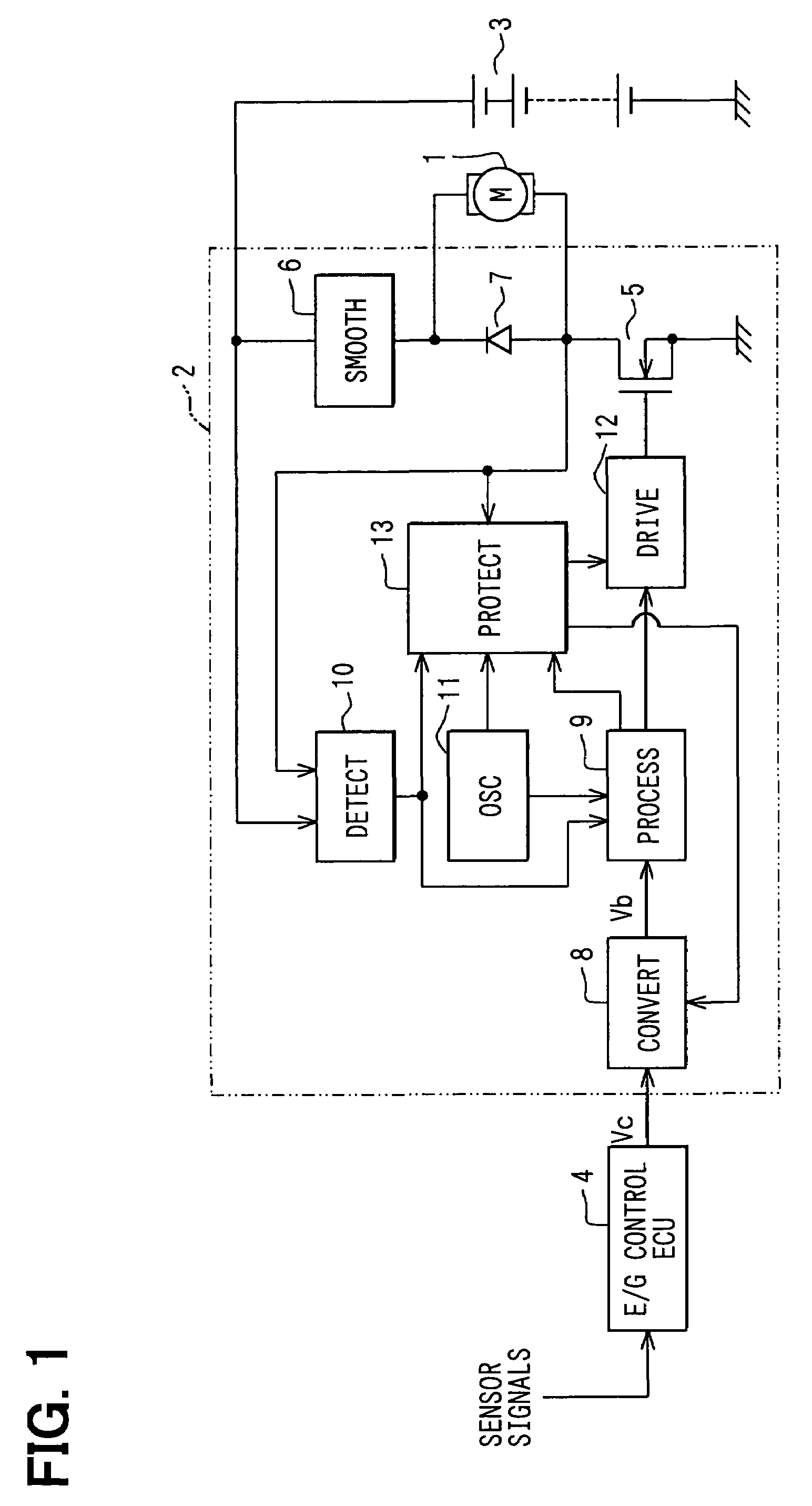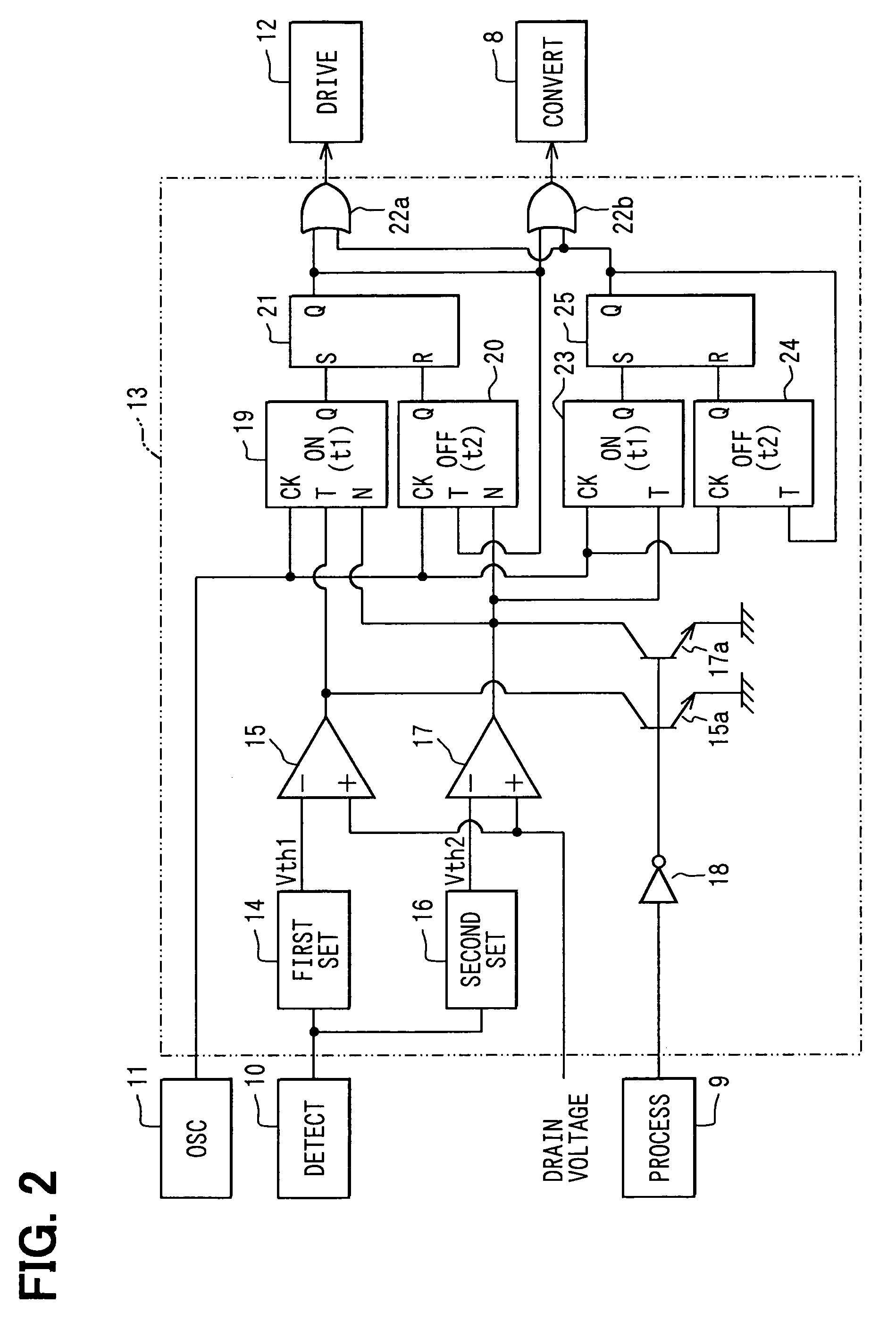Motor control apparatus
a technology of motor control and control module, which is applied in the direction of electric motor control, emergency protective circuit arrangement, light and heating apparatus, etc., can solve the problems of time delay in stopping the output of adverse effect of heat on the cooling function of the engine, and damage to the semiconductor switch device in the pwm control module, etc., to achieve high reliability
- Summary
- Abstract
- Description
- Claims
- Application Information
AI Technical Summary
Benefits of technology
Problems solved by technology
Method used
Image
Examples
first embodiment
[0024]Referring to FIG. 1, a direct current motor 1 serves as a driver of a blower fan (not shown) for cooling down engine cooling refrigerant flowing through the inside of a heat exchanger such as a radiator. A motor control apparatus 2 controls the rotating speed of a motor 1. A battery 3 supplies power to the motor control apparatus 2 by way of an ignition switch (not shown). It is to be noted that, in some configurations, the battery 3 supplies power to the motor control apparatus 2 directly.
[0025]The voltage applied to the motor 1 determines the rotating speed of the blower fan. The motor control apparatus 2 adjusts the level of the voltage by adoption of a pulse width modulation (PWM) control method of switching application of the output of the battery 3 to the motor 1. The motor control apparatus 2 has a configuration of receiving a voltage command signal Vc from an electronic control unit (ECU) 4 for an engine (E / G) control. The voltage command signal Vc is an output level c...
first embodiments
Modification of First Embodiments
[0091]The first embodiment can be modified as follows.
[0092]While the first embodiment has only 2 stages of combinations of an ON-timer and an OFF-timer, that is, the combination of the first ON-timer 19 and the first OFF-timer 20 as well as the combination of the second ON-timer 23 and the second OFF-timer 24, the number of such combination stages can also be increased to 3 or even a larger value. In a configuration including a larger number of such stages, the over-current protection operation can be carried out with higher accuracy in dependence on the magnitude of the motor current IM.
[0093]In addition, the timer operating ON time period t1 set in the first ON-timer 19 is set at a value greater than the timer operating ON time period t1′ set in the second ON-timer 23 to satisfy a relation of t1>t1′. On the other hand, the timer operating OFF time period t2 set in the first OFF-timer 20 is set at a value greater than the timer operating OFF time p...
second embodiment
[0095]The second embodiment shown in FIG. 6 is basically the same as the first embodiment shown in FIG. 1. In the second embodiment, however, a resistor 100 is connected between the negative side terminal of the motor 1 and a junction point between the MOSFET 5 and the flywheel diode 7. In addition, a voltage appearing between the ends of the resistor 100 is supplied to the over-current protection circuit 13.
[0096]In the over-current protection circuit 13 shown in FIG. 7, the motor current IM is detected as a current voltage (S3 in FIG. 8) appearing between the ends of the resistor 100. The over-current protection circuit 13 includes a low side over-current detection threshold voltage setting circuit 140 for setting a low side over-current detection threshold voltage Va (S1 in FIG. 8) corresponding to a low side threshold current. A low side determination comparator 150 compares the low side over-current detection threshold voltage Va output by the low side over-current detection th...
PUM
 Login to View More
Login to View More Abstract
Description
Claims
Application Information
 Login to View More
Login to View More - R&D
- Intellectual Property
- Life Sciences
- Materials
- Tech Scout
- Unparalleled Data Quality
- Higher Quality Content
- 60% Fewer Hallucinations
Browse by: Latest US Patents, China's latest patents, Technical Efficacy Thesaurus, Application Domain, Technology Topic, Popular Technical Reports.
© 2025 PatSnap. All rights reserved.Legal|Privacy policy|Modern Slavery Act Transparency Statement|Sitemap|About US| Contact US: help@patsnap.com



